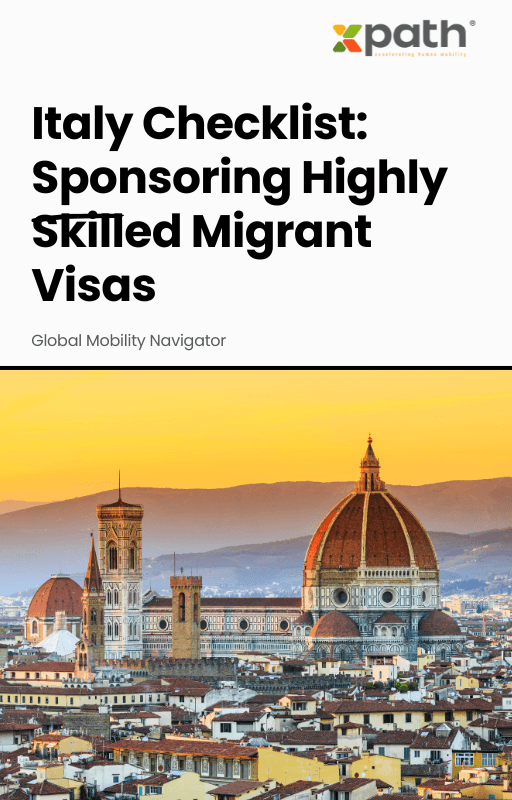Italy Checklist: Sponsoring Highly Skilled Migrant Visas
Grab a copy of a guide to international employee relocation
View E-bookThere’s a revolution happening in HR and global mobility. As more organizations turn to advanced platforms, cloud-based management tools, and cross-border compliance apps, ensuring your global mobility team is ready for a tech rollout has never been more crucial. After all, rolling out new technology can either feel like smooth sailing or navigating a ship through stormy waters. How prepared your team is can make all the difference.
Global mobility sits right at the intersection of talent management, compliance, and employee experience. According to a 2023 report by Deloitte, 60% of multinational organizations reported that optimized mobility platforms directly improved assignee satisfaction and reduced compliance risk. With distributed workforces and increasing employee expectations, seamless digital solutions aren’t just a nice-to-have—they’re essential.
The rollout of new technology in global mobility functions, from assignment management systems to automated tax compliance tools, is often the engine behind streamlined processes and cost savings. But with great tech comes great responsibility. Let’s make sure your team is buckled up and ready for the ride.
The digitalization of global mobility has been turbocharged by the rise of remote work and the growing complexity of international regulations. Data from PwC reveals that 73% of organizations are accelerating their investment in mobility technologies post-pandemic. Trends like AI-driven talent matching, digital immigration management, and integrated relocation dashboards are transforming how teams work.
Platforms like xpath.global are at the forefront, offering centralized solutions for relocation and cross-border workforce management. These technologies are helping companies cut assignment costs by up to 20% (as per 2022 KPMG Mobility Forum insights) while ensuring global compliance and better employee experiences. But buying the software is just step one; adoption is where the rubber meets the road.
Let’s face it—change can be scary, especially when it comes to HR technology. Yet the risks of not adopting modern solutions are even scarier. Manual processes lead to errors, compliance nightmares, and unhappy assignees. A 2021 EY survey found that 67% of mobility leaders cite lack of technology integration as their top challenge. Clearly, bridging this gap is a business imperative.
The question isn’t whether to go digital, but how to prepare your team to do so effectively. By getting everyone onboard early and addressing common roadblocks, your tech rollout can transform mobility from an administrative headache into a smart, strategic enabler for the entire organization.
Let’s walk through a practical roadmap you can follow to set your global mobility team up for tech-splendid success:
1. Assess Existing Processes and Pain Points
Before you can implement new tech, map out your current workflows. What’s working? Where do bottlenecks occur? Gather feedback from frontline users and stakeholders to make sure your tech solution targets real-world pain points.
2. Build Cross-Functional Buy-In Early
Global mobility is a team sport. Include IT, payroll, legal, and business units in your planning discussions. When everyone feels heard, adoption rates climb. Don’t forget to partner with those who handle data privacy and compliance!
3. Appoint a Dedicated Project Manager
Don’t leave this as a side gig. A dedicated project manager—ideally someone with mobility experience and tech acumen—keeps things on track and bridges gaps between external vendors (like xpath.global) and internal users.
4. Prioritize User Training and Change Management
The best technology in the world falls flat without proper training. Schedule hands-on sessions, create bite-sized tutorials, and establish ongoing user resources. Remember, change management is more marathon than sprint.
5. Stress-Test and Pilot Before Full Launch
Before flipping the switch, run a pilot with a small team or region. Gather feedback, fix bugs, and fine-tune workflows. It’s like a dress rehearsal before opening night.
6. Monitor, Measure, Adapt
After go-live, track metrics such as time-to-complete tasks, error rates, and user satisfaction. Use this data to adjust training and processes. Stay in touch with your vendor for ongoing updates and support.
Let’s bring this to life with a real-world example. A leading multinational (let’s call them TechNova) recently overhauled their global mobility program using xpath.global. Prior to rollout, assignment data was scattered across spreadsheets and emails, resulting in compliance gaps and constant stress for the mobility team. By migrating to xpath.global’s integrated platform, TechNova achieved a 30% reduction in administrative workload and a 98% on-time relocation rate for employees. The key to their success? Rigorous process mapping, clear training, and continuous communication, all anchored around an easy-to-use digital experience.
Are there potholes on the road to tech-enabled mobility? You bet. Underestimating the time needed for data migration, skipping the “softer” side of change management, or rolling out features faster than users can absorb them—these are classic mistakes. Remember, slow and steady wins the tech race. Don’t try to automate everything overnight, and above all, listen to your team’s feedback.
How long does a typical tech rollout take?
Timelines vary based on project scope, but most organizations need between three to six months for planning, piloting, and full deployment.
What’s the single most important ingredient for success?
User engagement—people need to know not just how but why to use the new tools.
How does xpath.global support our transition to digital?
xpath.global offers onboarding, training, and ongoing support tailored to your organization’s needs, making adoption seamless for teams of all sizes.
Is data migration a challenge?
It can be. Work with your provider and IT to map out a phased migration and run quality checks before going live.
How quickly will we see ROI?
Most companies start seeing efficiency gains and improved compliance within the first year of full adoption, often much sooner for administrative savings and employee satisfaction.
Ready to transform your mobility program? Explore xpath.global’s solutions.

Italy Checklist: Sponsoring Highly Skilled Migrant Visas
Grab a copy of a guide to international employee relocation
View E-book